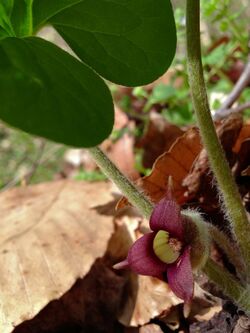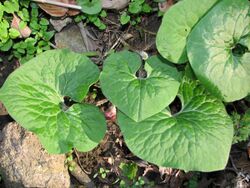Biology:Asarum canadense
| Asarum canadense | |
|---|---|

| |
| Scientific classification | |
| Kingdom: | Plantae |
| Clade: | Tracheophytes |
| Clade: | Angiosperms |
| Clade: | Magnoliids |
| Order: | Piperales |
| Family: | Aristolochiaceae |
| Genus: | Asarum |
| Species: | A. canadense
|
| Binomial name | |
| Asarum canadense | |
| Synonyms | |
|
A. acuminatum | |
Asarum canadense, commonly known as Canada wild ginger, Canadian snakeroot, and broad-leaved asarabacca, is a herbaceous, perennial plant which forms dense colonies in the understory of deciduous forests throughout its native range in eastern North America, from the Great Plains east to the Atlantic Coast, and from southeastern Canada south to around the Fall Line in the southeastern United States .
It is protected as a state threatened species in Maine.[2]
Description
Its leaves are velvety, kidney-shaped, and persistent, exhibiting a unique iridescence when in full sun. Underground shoots are shallow-growing, fleshy rhizomes that branch to form a clump. Flowers bloom from April through June.[3] Flowers are hairy and have three sepals. They are tan to purple in color on the outside and are lighter on the inside, with tapered tips and bases fused into a cup.
Pollinated flowers develop into a pod, which splits open when ripe to reveal seeds with elaiosomes, structures that are eaten by ants (myrmecochory).[4]
The diploid chromosome number is 26.[5]
Toxic substance
The plant contains aristolochic acid, a carcinogenic compound. The United States Food and Drug Administration warns that consumption of aristolochic acid-containing products is associated with "permanent kidney damage, sometimes resulting in kidney failure that has required kidney dialysis or kidney transplantation. In addition, some patients have developed certain types of cancers, most often occurring in the urinary tract."[6]
Uses
The long rhizomes of A. canadense were used by Native Americans as a seasoning.[5] It has similar aromatic properties to true ginger (Zingiber officinale), but should not be used as a substitute because it contains an unknown concentration of the carcinogen aristolochic acid and asarone.[7] The distillate from the ground root is known as Canadian snakeroot oil. The odor and flavor are spicy. It has been used in many flavor preparations.[8]
Native Americans used the plant as a medicinal herb to treat a number of ailments including dysentery, digestive problems, swollen breasts, coughs and colds, typhus, scarlet fever, nerves, sore throats, cramps, heaves, earaches, headaches, convulsions, asthma, tuberculosis, urinary disorders, and venereal disease. In addition, they also used it as a stimulant or appetite enhancer, and as a charm. It was also used as an admixture to strengthen other herbal preparations.[5]
References
- ↑ "Asarum canadense". NatureServe Explorer. NatureServe. http://www.natureserve.org/explorer/servlet/NatureServe?searchName=Asarum+canadense+. Retrieved 2007-12-15.
- ↑ "Asarum canadense". Natural Resources Conservation Service PLANTS Database. USDA. https://plants.usda.gov/core/profile?symbol=ASCA.
- ↑ , Lady Bird Johnson Wildflower Center, University of Texas at Austin, http://www.wildflower.org/plants/result.php?id_plant=, retrieved 8 November 2015
- ↑ Heather Holm (2015). "Wild Ginger Seed Dispersal". http://www.restoringthelandscape.com/2012/06/wild-ginger-seed-dispersal.html.
- ↑ 5.0 5.1 5.2 Whittemore, Alan T.; Mesler, Michael R.; Lu, Karen L. (1997), "Asarum canadense", in Flora of North America Editorial Committee, Flora of North America North of Mexico (FNA), 3, New York and Oxford, http://www.efloras.org/florataxon.aspx?flora_id=1&taxon_id=
- ↑ [1] April 11, 2001.
- ↑ Duke, Jim, "Asarum canadense", Dr. Duke's Phytochemical and Ethnobotanical Databases, https://phytochem.nal.usda.gov/phytochem/plants/show/201?et=
- ↑ Michael G. Motto, Norman J. Secord (1985), "Composition of the essential oil from Asarum canadense", Journal of Agricultural and Food Chemistry 31 (5): 789–791, doi:10.1021/jf00065a004.
External links
- Illinois Wildflowers
- "Wild Ginger". St. Olaf College. https://wp.stolaf.edu/naturallands/forest/ephemerals/wildginger/.
Wikidata ☰ Q2866323 entry
 |




